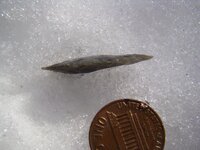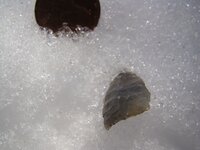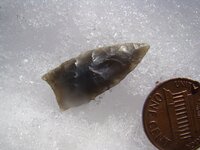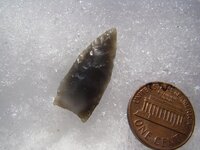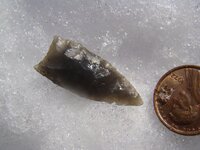Navigation
Install the app
How to install the app on iOS
Follow along with the video below to see how to install our site as a web app on your home screen.
Note: This feature may not be available in some browsers.
More options
You are using an out of date browser. It may not display this or other websites correctly.
You should upgrade or use an alternative browser.
You should upgrade or use an alternative browser.
Mighty-fine Madison?
- Thread starter eastTNJoe
- Start date
NCPeaches
Silver Member
Not sure of the type but it's a beauty!
yakker
Bronze Member
- Jan 20, 2012
- 1,663
- 1,240
- Detector(s) used
- spec enhanced eyeballs
- Primary Interest:
- All Treasure Hunting
It's hard to see a ground base (though I was hoping to see that, maybe you can see it- That's what I was 'Seeing' last night...), but the flute seems to be there. Maybe Pigeon Side Notch... see what you think- according to this (from Archaeology at Wilson-Warren.edu (the flake patterns don't seem to be right though).

I don't have time now- and I was too tired last night to get a proper look at it (it's a beauty, BTW). x2 check base. Flute, right? Is it exhausted or simply small/ secondary flaking? Lovely material
I'll keep looking when I can home from work.
Maybe someone else will jump in, hopefully...

(Keel)
This triangular blade has concave or straight sides. The length is twice the width. The base can be incurvate, excurvate, or straight and thinned with pressure flaking. The side notches are very shallow measuring 1 mm deep and 1-3 mm wide. Points range from 28-39 mm long, 13-23 mm wide, and 6-8 mm thick. This point is made by percussion-flaking with pressure-flaking along the edges and side notches. This is an Early Woodland point.
This triangular blade has concave or straight sides. The length is twice the width. The base can be incurvate, excurvate, or straight and thinned with pressure flaking. The side notches are very shallow measuring 1 mm deep and 1-3 mm wide. Points range from 28-39 mm long, 13-23 mm wide, and 6-8 mm thick. This point is made by percussion-flaking with pressure-flaking along the edges and side notches. This is an Early Woodland point.
I don't have time now- and I was too tired last night to get a proper look at it (it's a beauty, BTW). x2 check base. Flute, right? Is it exhausted or simply small/ secondary flaking? Lovely material

I'll keep looking when I can home from work.
Maybe someone else will jump in, hopefully...
old digger
Gold Member
- Jan 15, 2012
- 7,512
- 7,352
- Detector(s) used
- White's MXT
- Primary Interest:
- All Treasure Hunting
That sure is a beautiful point, I wouldn't mind finding one like that. 
Flea-bit Monkey
Sr. Member
- Apr 25, 2013
- 275
- 364
- Primary Interest:
- Relic Hunting
Beautiful material. Sweet one!!!!
quito
Silver Member
Are the edges ground near the base?
eastTNJoe
Hero Member
- Mar 4, 2013
- 544
- 616
- Primary Interest:
- All Treasure Hunting
- Thread starter
- #13
It's hard to see a ground base (though I was hoping to see that, maybe you can see it- That's what I was 'Seeing' last night...), but the flute seems to be there. Maybe Pigeon Side Notch... see what you think- according to this (from Archaeology at Wilson-Warren.edu (the flake patterns don't seem to be right though).
(Keel)
This triangular blade has concave or straight sides. The length is twice the width. The base can be incurvate, excurvate, or straight and thinned with pressure flaking. The side notches are very shallow measuring 1 mm deep and 1-3 mm wide. Points range from 28-39 mm long, 13-23 mm wide, and 6-8 mm thick. This point is made by percussion-flaking with pressure-flaking along the edges and side notches. This is an Early Woodland point.
I don't have time now- and I was too tired last night to get a proper look at it (it's a beauty, BTW). x2 check base. Flute, right? Is it exhausted or simply small/ secondary flaking? Lovely material
I'll keep looking when I can home from work.
Maybe someone else will jump in, hopefully...
Thanks for all the input!
Here are some more pics
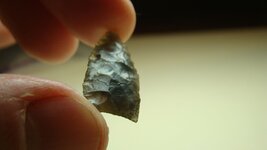
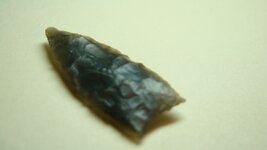
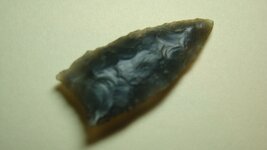
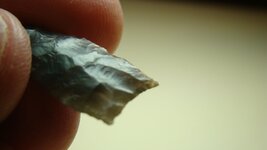
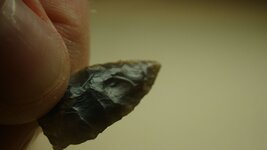
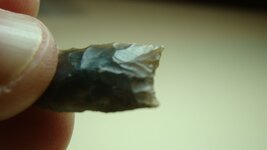
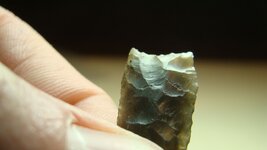
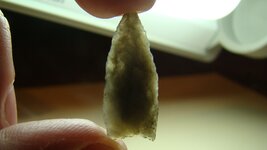
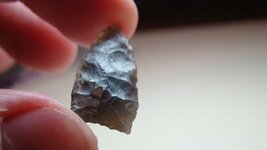
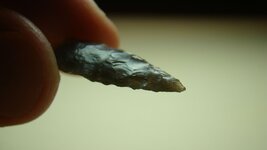
- Jan 27, 2009
- 18,797
- 11,917
- 🥇 Banner finds
- 1
- Detector(s) used
- Tesoro Conquistador freq shift
Fisher F75
Garrett AT-Pro
Garet carrot
Neodymium magnets
5' Probe
- Primary Interest:
- All Treasure Hunting
Joe you are right enough. They are Mississippian just like guntersvile hamiltons and madison. They are common in your area. I have a pile of them if you want to see some like examples.All in our Dallas phase. Base not ground. Its an arrow point.
You found a real nice one
You found a real nice one
Last edited:
eastTNJoe
Hero Member
- Mar 4, 2013
- 544
- 616
- Primary Interest:
- All Treasure Hunting
- Thread starter
- #15
Joe you are right enough. They are Mississippian just like guntersvile hamiltons and madison. They are common in your area. I have a pile of them if you want to see some like examples.All in our Dallas phase. Base not ground. Its an arrow point.
You found a real nice one
Thanks TNMTNS…of course I want to see some of yours! Post some pics! Hope you are doing well...
- Jan 27, 2009
- 18,797
- 11,917
- 🥇 Banner finds
- 1
- Detector(s) used
- Tesoro Conquistador freq shift
Fisher F75
Garrett AT-Pro
Garet carrot
Neodymium magnets
5' Probe
- Primary Interest:
- All Treasure Hunting
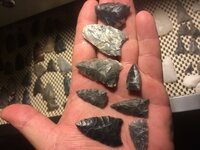
Some will have a bifurcate base some won't. They made some of these even bigger and some very small. I have found then from about 30 miles above you to 50 miles below. This is just a few. Some of the work is fantastic as what you see in yours. If they are longer thinner they go in to the guntersville category . Dallas era triangle form the Chickamauga basin.
eastTNJoe
Hero Member
- Mar 4, 2013
- 544
- 616
- Primary Interest:
- All Treasure Hunting
- Thread starter
- #17
View attachment 1126606
Some will have a bifurcate base some won't. They made some of these even bigger and some very small. I have found then from about 30 miles above you to 50 miles below. This is just a few. Some of the work is fantastic as what you see in yours. If they are longer thinner they go in to the guntersville category . Dallas era triangle form the Chickamauga basin.
Thanks man! Awesome info. My gut told me it was somewhere in the Guntersville/Madison range…but the little bit of stuff I've found at this spot was way earlier in era... so it seemed out of place a bit. I always appreciate your expertise.
- Jan 27, 2009
- 18,797
- 11,917
- 🥇 Banner finds
- 1
- Detector(s) used
- Tesoro Conquistador freq shift
Fisher F75
Garrett AT-Pro
Garet carrot
Neodymium magnets
5' Probe
- Primary Interest:
- All Treasure Hunting
Well the window you hunt is what 13,000 + to trade goods to removal. It has it all.Many types named for your area. Hope all is well. Tell your Dad I said "Howdy".
Top Member Reactions
-
 3347
3347 -
 1902
1902 -
 1858
1858 -
 1160
1160 -
 1088
1088 -
 880
880 -
 843
843 -
 842
842 -
 827
827 -
 768
768 -
 766
766 -
 545
545 -
 517
517 -
 496
496 -
 439
439 -
 427
427 -
E
418
-
 402
402 -
 397
397 -
 394
394
Users who are viewing this thread
Total: 2 (members: 0, guests: 2)
